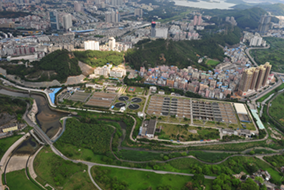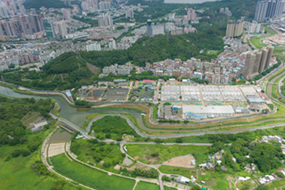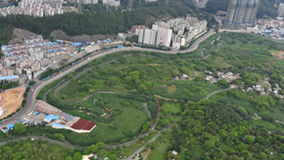Shenzhen River Regulation Project
Shenzhen River is the boundary river between the Hong Kong Special Administrative Region (HKSAR) and the Shenzhen Special Economic Zone. It originates near Niuweiling of the Wutong Mountain, flowing from northeast to southwest into Deep Bay. The total length of Shenzhen River is 37 km, with a catchment area of 312 km2. It is the drainage outlet of Ng Tung River, Ping Yuen River and the San Tin streams on Hong Kong side as well as that of Shawan River, Buji River and Futian River on Shenzhen side. Regional flooding in these river catchments was frequently threatening the public safety and properties on both sides of the Shenzhen River.
The Government of HKSAR and the Shenzhen Municipal Government are determined to regulate the Shenzhen River. A Joint Working Group on Regulation of the Shenzhen River has been set up to oversee the project implementation. The Drainage Services Department worked closely with the Shenzhen side in the planning, design and construction of the project.
The project consists of a four-stage scheme. The first three stages straighten, widen and deepen the previous 18km of Shenzhen River into 13.5 km of new river channel. While the main objective of the works is flooding prevention, it also has other associated benefits such as improving the river environment and navigation. Stage IV project further improves 4.5km natural stream at the upstream of the trained Shenzhen River in order to raise the flood prevention standard near the proposed Liantang/Heung Yuen Wai Control Point.
Stage I : Straightening of the Lok Ma Chau bend and the Liu Pok bend;
Stage II : Widening and deepening of the remaining sections from Liu Pok bend to the estuary;
Stage III : Widening and deepening of the section upstream of the Liu Pok bend to the confluence with the Ping Yuen River; and
Stage IV : Improving of the section upstream of the confluence with the Ping Yuen River to Pak Fu Shan(including Liantang/Heung Yuen Wai Control Point).
Stage I and Stage II works of the Shenzhen River Regulation Project are the most critical flood mitigation projects in the Northern New Territories. They cost about HK$300 million and HK$850 million, and were completed in 1997 and 2000, respectively. The new river channel is 9.5 km long. The flow capacity of Shenzhen River from Lo Wu to its estuary at Deep Bay has been significantly increased and, together with other river training works in the upstream, have basically eliminated the regional flooding in the North New Territories.
The Shenzhen River Regulation Project Stage Ⅲ is divided into two phases. Phase I covers the advance works for the reconstruction of border roads and fences. The river training works under Phase II are divided into 3 contracts, which involve river dredging, channel straightening, construction of river embankments, channel lining protection works, reconstruction or strengthening of 5 bridges (Lo Wu Railway Bridge, old footbridge, Man Kam To Bridge, etc.), improvement works to Dongjiang-Shenzhen watermains, environmental improvement works and landscaping works. The project costs about HK$650 million and the new river channel is 4km long.
The Shenzhen River Regulation Project Stage IV covers the advance works for the reconstruction of border roads and fences and the river training works. The river training works involve river widening, construction of river embankments, channel lining protection works, re-construction of a footbridge (Lo Fong Bridge), construction of a flood retention lake of 80,000m3, environmental improvement works and landscaping works. The project costs about HK$840 million and the new river channel is 4.5km long.
Upon the successful implementation of Shenzhen River Regulation Project (Stage I to IV), Shenzhen River has been straightened, widened and deepened, and is no longer a narrow and sinuous river covered by wild vegetations. The whole trained Shenzhen River section has a flood protection level of a one-in-50 year return period.
Shenzhen River Before and After River Training
| Before River Training | After River Training |
|---|---|
 |
 |
| Lo Wu | Lo Wu |
 |
 |
| Yuen Leng Chai | Yuen Leng Chai |
 |
 |
| Upstream of Man Kam To Bridge | Upstream of Man Kam To Bridge |
 |
 |
| Confluence with Ping Yuen River | Confluence with Ping Yuen River |
 |
 |
| Flood Retention Lake | Flood Retention Lake |
Shifting and Preservation of Lo Wu Railway Bridge
The training of the Shenzhen River requires the reconstruction of the old Lo Wu Railway Bridge. Because of its high historical value that could be traced back to 1945, both Governments decided to preserve the Lo Wu Railway Bridge at the site adjacent to the river and the Lo Wu Railway Station so that people can have a view of the bridge that recalls their old memory.
A system of pulley and trolley was used to shift the old Lo Wu Railway Bridge to its final position. This construction method enabled the whole Bridge to be preserved in its original form without causing any damage.
 |
 |
| Lo Wu Railway Bridge at night | Preserved Lo Wu Railway Bridge |
 |
| Shifting of Lo Wu Railway Bridge |
Construction of Flood Retention Lake
The objective of constructing a flood retention lake under Stage IV regulation project is to attenuate peak flows discharging to the existing downstream Shenzhen River. Major components include an inlet overflow weir system, an outlet sluice, and a flood retention lake of 80,000m3. It is adopted to integrate an ecological sustainable development approach in the design to flood alleviation.
During heavy rainstorm events, the flood retention lake will temporarily store part of the stormwater collected from the upstream river to keep the downstream water level under control. Apart from enhancing the capacity of drainage channels, ecological features are included in the design. Wetland flora and riverbank greening elements will be planted to provide habitats for plants and animals and to enrich the ecology of Shenzhen River.
Project Information
| Shenzhen River Regulation Project | Construction Cost (HK$ million) | Commencement Date | Completion Date |
|---|---|---|---|
|
Stage I |
300 |
5/1995 |
1/1997 |
|
Stage II |
840 |
11/1996 |
6/2000 |
|
Stage III |
655 |
12/2001 |
11/2006 |
|
Stage IV |
About 840 |
3/2012 | 7/2017 |
